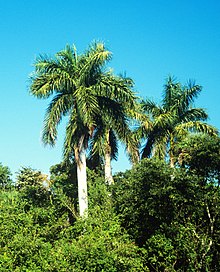Roystonea regia
| Royal palm | |
|---|---|
 |
|
| Native habitat in Collier-Seminole State Park, Florida | |
| Scientific classification | |
| Kingdom: | Plantae |
| (unranked): | Angiosperms |
| (unranked): | Monocots |
| (unranked): | Commelinids |
| Order: | Arecales |
| Family: | Arecaceae |
| Subfamily: | Arecoideae |
| Tribe: | Roystoneae |
| Genus: | Roystonea |
| Species: | R. regia |
| Binomial name | |
|
Roystonea regia (Kunth) O.F.Cook |
|
| Synonyms | |
|
Oreodoxa regia Kunth |
|
Oreodoxa regia Kunth
Oenocarpus regius (Kunth) Spreng.
Palma elata W.Bartram
Roystonea floridana O.F.Cook
Euterpe jenmanii C.H.Wright
Euterpe ventricosa C.H.Wright
Roystonea jenmanii (C.H.Wright) Burret
Roystonea elata (W.Bartram) F.Harper
Roystonea ventricosa (C.H.Wright) L.H.Bailey
Roystonea regia var. hondurensis P.H.Allen
Roystonea regia, commonly known as the Cuban royal palm, Florida royal palm, or simply the royal palm is a species of palm which is native to southern Florida, Mexico and parts of Central America and the Caribbean. A large and attractive palm, it has been planted throughout the tropics and subtropics as an ornamental tree. Although it is sometimes called R. elata, the conserved name R. regia is now the correct name for the species. Populations in Cuba and Florida were long seen as separate species, but are now considered to belong to a single species.
Best known as an ornamental, R. regia is also used as a source of thatch, construction timber, and in some forms of so-called traditional medicine, although there is currently no valid scientific evidence to support the efficacy or use of any palm species for medicinal purposes. The fruit is eaten by birds and bats (which disperse the seeds) and fed to livestock. Its flowers are visited by birds and bats, and it serves as a roosting site and food source for a variety of animals. Roystonea regia is the national tree of Cuba, and has a religious role both in Santería and Christianity, where it is used in Palm Sunday observances.
...
Wikipedia
